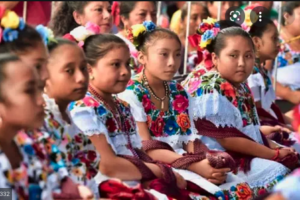Mexican officials said the employees’ behavior undermined indigenous people and communities
por Mexico News Daily
A French fashion label attacked the dignity of indigenous communities by filming a Zapotec woman dancing in its new clothing line, the National Institute of Indigenous Peoples (INPI) charged.
Sézane, a clothing line founded in Paris in 2013, dressed women in their clothes in the market at Teotitlán del Valle, in the Central Valleys region of Oaxaca, on January 8.
In a video uploaded to social media, a publicity team can be seen photographing an elderly indigenous woman against a professional backdrop. One representative encourages the woman to stand up and sway from side to side to a recording of the 1968 Mary Hopkin song, Those Were the Days playing in the background. Several spectators watch the moment, and laughter can be heard in the background of the video.
INPI said in a statement that the behavior of the Sézane representatives “undermines the dignity of [indigenous] peoples and communities and reinforces racist stereotypes about indigenous culture and traditions,” before adding that legal action was being considered. “There will be dialogue with the authorities of Teotitlán and the aggrieved people to undertake a legal action, in accordance with the law.”
The agency demanded companies “cease exploiting indigenous and Afro-Mexican peoples and communities as cultural capital since they are not objects of clothing but citizens under public law who possess a vast cultural heritage and traditional knowledge.”
It cited Article 2 of the United Nations Declaration on the Rights of Indigenous Peoples: “Indigenous peoples and individuals are free and equal to all other peoples and individuals and have the right to be free from any kind of discrimination, in the exercise of their rights, in particular that based on their indigenous origin or identity.”
A new piece of legislation in Mexico, Article 21 of the Federal Law on the Protection of the Cultural Heritage of Indigenous and Afro-Mexican Peoples and Communities, is set to become law pending presidential approval and aims to protect the “dignity and cultural integrity of indigenous and Afro-Mexican peoples.”
Sézane has stores in New York, Madrid, London and France and focuses on vintage styles.
The fashion industry has consistently come under fire in Mexico for the alleged exploitation of indigenous culture and designs. The federal Culture Ministry announced in May, 2021 that it had sent letters to Anthropologie as well as Zara and Patowl for the “improper cultural appropriation” of designs from Oaxaca.
The federal government and other authorities have previously accused several other international brands of plagiarizing indigenous Mexican designs. Among them are Zimmerman, Isabel Marant, Carolina Herrera, Mango and Pippa Holt.
With reports from El Universal
https://twitter.com/i/status/1480439186327015428
Indigenous languages support seen as low priority for federal government
Federal government wants to incorporate 2 federal indigenous support agencies into 1
A proposal to incorporate the National Institute of Indigenous Languages (INALI) into the National Institute of Indigenous Peoples (INPI) shows that protecting native tongues is not a priority for the federal government, according to Mexico’s representative to the United Nations Permanent Forum on Indigenous Issues (UNPFII).
The office of President López Obrador is proposing that the INALI, which was established in 2005, become part of the INPI, which was created by the current government in 2018 but continues the work of the now-defunct National Commission for the Development of Indigenous Peoples.
Irma Pineda, a Zapotec poet from Oaxaca who began her term as a representative to the UNPFII at the start of 2020, told the newspaper Milenio that the proposal would have an adverse effect on the former institute and goes against Mexico’s support for indigenous languages via the United Nations, which declared the period between 2022 and 2032 as the International Decade of Indigenous Languages.
“[INALI] would have less ability to design and establish linguistic policies at the national level,” she said.
“All this is regrettable, … [the proposal sends] a very bad message to indigenous people because it says that indigenous languages don’t matter much or they’re not a priority or that languages will be allowed to disappear,” Pineda said.
She noted that López Obrador participated in an indigenous cleansing ceremony on the day of his inauguration as president but his administration is now sending “very contradictory” messages with regard to its support for the nation’s indigenous people.
Pineda asserted that the INALI would face additional budget cuts as well as staffing cuts if it is absorbed into the INPI. She also claimed that the policy areas over which it has influence will be reduced.
Fernando Nava, the director and founder of the INALI, also opposes the plan to make the institute part of the INPI.
“In Mexico, we took a long time to give a special place to indigenous languages, and in less than 20 years, the institute is losing its autonomy,” he said.
The government’s proposal is indicative of a “sociopolitical disinterest” in indigenous languages, Nava said.
“At the beginning of the decade, attention to and the budget of the institutional space dedicated to languages was reduced,” he said.
More than 60 indigenous languages are spoken in Mexico, but many are considered endangered.
Practices such as Castilianization, which aim to convert speakers of an indigenous language to Spanish speakers, continue to exist in the state of Chiapas and exacerbate the risk of native languages disappearing, researchers from Western Kentucky University said last year after commissioning a survey in Mexico that included questions related to indigenous issues.
With reports from Milenio




